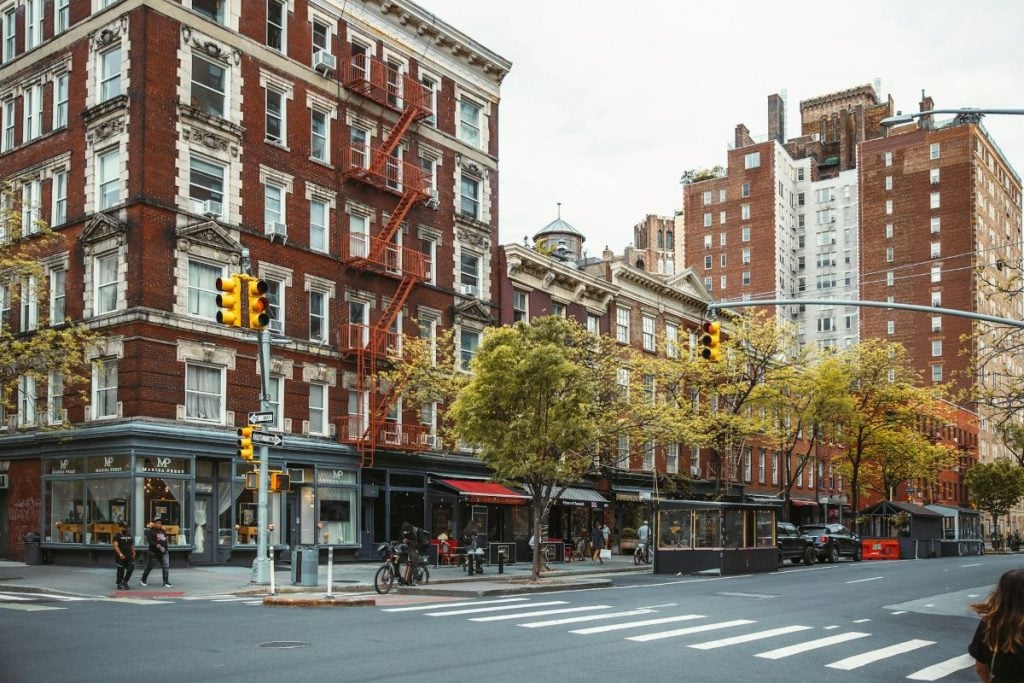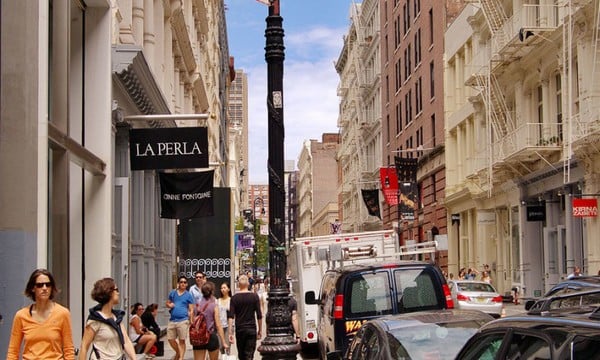For many, SoHo's cast-iron buildings, open-floor layouts, and creative energy capture the quintessential New York City dream. But as someone who spent over a decade living in SoHo lofts, I can say with complete confidence that the romantic image often overshadows the complex reality.
Live/work lofts, in particular, hold a unique place in the market. They embody flexibility and freedom, yet exist within a web of zoning complications, legal gray areas, and shifting buyer demand. While these properties command a premium because of their square footage and design appeal, they sell at a discount compared to more conventional residential units nearby.
Let’s explore why.
What is a Live/Work Loft?
Live/work lofts are large, typically open-plan spaces that allow for both residential living and some form of business or artistic work. These spaces are often located in converted commercial or manufacturing buildings, many of which date back over a century.
SoHo became famous in the 1960s and 70s as artists began to illegally occupy empty industrial buildings in search of large, affordable spaces to both live and create. Eventually, many of these squats were formalized under city-backed programs, giving birth to today’s iconic SoHo loft culture.
Unlike traditional apartments, live/work lofts are rarely cookie-cutter. Each one has its own quirks, layout, and history. That uniqueness is part of the charm—but it also means increased complexity when it comes to buying, selling, or even renting them.
Understanding the Zoning Issues
Before falling in love with a SoHo loft, it’s critical to understand how zoning laws affect its use. This is where many buyers (and even some agents) get tripped up.
Much of SoHo is still zoned for manufacturing under classifications such as M1-5A and M1-5B. These zones were initially intended for light industrial use, not for residential living. Residential use is not strictly allowed in these buildings unless certain conditions are met.
JLWQA: The Artist-in-Residence Loophole
The city introduced a workaround in the 1980s called Joint Living-Work Quarters for Artists (JLWQA). This zoning exception permits certified artists to live and work in manufacturing-zoned buildings legally. The idea was to protect the creative class while still honoring the intent of the zoning rules.
However, this workaround comes with restrictions:
-
You must be certified as an artist by the New York City Department of Cultural Affairs.
-
Certification requires proof of artistic practice and income derived from that work.
-
Not all buildings accept uncertified residents, especially in co-ops with artist-only clauses.
While enforcement of these rules is lax in many buildings, the legal risk is still present. It creates uncertainty for both buyers and lenders, affecting everything from mortgage approval to resale value.
Why Live/Work Lofts Often Sell at a Discount
Many people assume that a large, flexible loft in SoHo would command top dollar. In reality, these spaces often sell for significantly less per square foot than neighboring condos. The reasons are as much legal and practical as they are emotional.
Core Factors Depressing Value
-
Zoning Ambiguity: Buyers worry about enforcement or future legal changes.
-
Financing Challenges: Many banks are cautious about lending on live/work properties due to their non-traditional zoning.
-
Insurance Complexity: Mixed-use coverage can be expensive and harder to obtain.
-
Fewer Amenities: Most of these buildings lack doormen, gyms, or concierge services.
-
Unpredictable Resale: Uncertainty makes it harder to gauge long-term appreciation.
These factors combine to reduce competition, suppress price per square foot, and lengthen time on market.
Price Comparison Table
|
Property Type |
Location |
Size (sq ft) |
List Price |
Price/Sq Ft |
Zoning Type |
Amenities |
|---|---|---|---|---|---|---|
|
Live/Work Loft |
West Broadway |
2,000 |
$2.8M |
$1,400 |
M1-5B |
None |
|
Modern Condo |
Crosby Street |
1,400 |
$3.1M |
$2,215 |
R10A |
Doorman, gym |
|
Prewar Co-op Apartment |
Sullivan Street |
1,200 |
$1.95M |
$1,625 |
R7B |
Elevator |
As you can see, the live/work loft offers the most space, but at a price that reflects legal uncertainty and fewer amenities.
Who Actually Buys These Lofts?
Live/work lofts aren’t for everyone, but they have a loyal and informed buyer base. Typically, these buyers are either highly creative, financially flexible, or both.
Ideal Buyer Profiles
-
Certified Artists: The original intended occupants who benefit most from the zoning.
-
Entrepreneurs and Founders: Those needing office space but unwilling to commit to commercial leases.
-
Designers and Architects: Visual professionals who thrive in open-plan, natural light environments.
-
Cash Buyers: Those who can bypass financing complications.
In general, these buyers are already familiar with SoHo's real estate ecosystem and know exactly what they’re getting into.
How Buyer Demand Has Evolved
In the past two decades, the profile of SoHo loft buyers has changed significantly. There’s been a clear shift away from artists and toward professionals looking for cachet and character in a work-from-home world.
At the same time, the explosion of luxury condos has raised the bar for what buyers expect, even in historically raw spaces.
Then vs. Now: Buyer Priorities
|
Feature |
2000s Buyer Priority |
2025 Buyer Priority |
|---|---|---|
|
Space and light |
High |
Moderate |
|
Location |
High |
High |
|
Legal residential use |
Low |
High |
|
Amenities |
Low |
High |
|
Architectural character |
High |
Moderate |
|
Financing ease |
Low |
High |
Younger buyers today tend to prefer turn-key solutions with modern comforts. While they still admire exposed brick and 14-foot ceilings, they're less likely to sacrifice stability and legality for aesthetic appeal.
The Legal Risks of Loft Living
The most misunderstood aspect of owning a SoHo live/work loft is the legal gray area. Many of these properties are, by law, not meant for full-time residential use. That fact can have profound implications.
Potential Legal Issues
-
Department of Buildings Violations: Living in an unapproved unit can result in vacate orders or fines.
-
Mortgage Denial: Banks may refuse to finance purchases in buildings not zoned for residential use.
-
Insurance Gaps: Traditional renters or homeowners insurance may not cover business activity or loft living.
-
Tax Classification: Some loft buildings are assessed as commercial properties, resulting in higher taxes.
That said, many of these problems are avoidable or manageable if you work with a knowledgeable attorney and real estate agent.
My Firsthand Experience in SoHo
I spent ten years living in two different SoHo live/work lofts, and I can tell you the experience was nothing short of transformative. These spaces offered me creative freedom, endless light, and a deep connection to New York’s cultural heartbeat.
But I also dealt with no central AC, haphazard board management, and inconsistent heating. One elevator broke down every other week. Once, a buyer’s bank walked away from a deal at the eleventh hour due to zoning concerns.
The highs were high, but the frustrations were real. If you’re the type of person who thrives in organized environments or expects hotel-like services, these spaces may test your patience.
What About Renting a Live/Work Loft?
Renting is a great way to experience SoHo loft life without the long-term risks of ownership. It’s also a more accessible option for those who don’t meet artist certification requirements or lack the cash to purchase.
Pros of Renting
-
Lower commitment
-
No exposure to resale or financing risk
-
Flexible lease structures
-
Opportunity to live creatively
Cons of Renting
-
Lease restrictions may limit business activity
-
Insurance requirements are still complicated
-
No equity or tax benefits
-
Landlords may not handle repairs promptly in older buildings
In many cases, renters are treated as unofficial guests of the space’s zoning loopholes. It works, until it doesn’t.
How to Buy One Safely
If you’re serious about buying a live/work loft in SoHo, the best advice is to prepare thoroughly and build the right team around you.
Key Steps to Consider
-
Hire a zoning-savvy real estate attorney
They will review use certificates, zoning maps, and any restrictions tied to JLWQA designations.
-
Work with a local agent experienced in loft sales
Not every broker understands how to navigate these transactions.
-
Consider paying in cash
This circumvents many of the mortgage issues tied to zoning and occupancy.
-
Get specialty insurance quotes upfront
Understand what your business and residence need for coverage.
-
Confirm your long-term plans align with the space
If you're not planning to use it as a hybrid space, you may not be maximizing its value.
When a Live/Work Loft is the Right Investment
Despite all the caveats, live/work lofts still hold a powerful allure. There are circumstances in which they make sense financially and practically.
Scenarios Where They Work Well
-
You plan to stay for 10+ years and can weather short-term market fluctuations.
-
You already run a business or studio and would otherwise rent commercial space.
-
You want to avoid amenity fees common in full-service buildings.
-
You value uniqueness and are willing to work around inconveniences.
They may not be the best bet for the average investor, but for the right person, these lofts can be both inspiring and cost-effective over time.
What to Watch in the Future
SoHo zoning is under review as the city attempts to modernize outdated maps and adapt to a post-COVID world. A pilot program has explored ways to make these buildings legally residential or allow non-artists to use them more freely.
Any change could dramatically alter the value proposition. A building that is legalized overnight may see prices jump. Conversely, tighter enforcement could suppress values further.
If you’re considering buying, keep one eye on legislative trends and community board discussions. The SoHo Alliance and Community Board 2 are good starting points for updates.
Think You're Ready for Loft Life?
Live/work lofts in SoHo aren’t just properties. They are lifestyles, legal puzzles, and cultural artifacts wrapped into one. Whether or not they are "worth the premium" depends mainly on how you define value.
Do you crave space, light, and legacy? Or do you need comfort, legality, and peace of mind?
For those who can navigate the chaos, these spaces remain some of the most unique and rewarding homes in New York City. But they are not for the faint of heart or the ill-informed.
Take the Next Step Toward Loft Living
If you’re curious about buying or renting a live/work loft in SoHo, the first step is education. Get in touch with professionals who understand the terrain, and make sure your priorities align with what these spaces actually offer.
As someone who has lived the loft life, I can help you evaluate whether it’s right for you. Feel free to reach out for property insights, zoning clarifications, or even just stories from the golden age of SoHo loft culture. There’s nothing quite like it, and you deserve to step into it with clarity and confidence.



